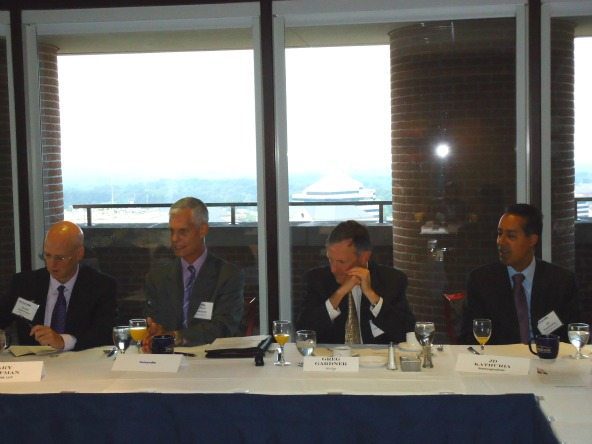
The former director of the Intelligence Community’s DNI Open Source Center, Douglas (Doug) Naquin, spoke at a WashingtonExec breakfast roundtable on the topic of mobile computing in government.
The intimate breakfast (held at The Tower Club Tysons Corner) included mobile leads, CTOs, CIOs and CEOs of small, emerging and large federal contracting companies focused on the intelligence and mobile spaces. Greg Gardner, former Deputy CIO for the Intelligence Community and Chief Architect of Government and Defense Solutions at NetApp moderated the event.
Naquin first noted that most current IT – and even organizational—strategies comprise between one and all four of the following: “big data”; moving to the “cloud”; cyber/information assurance; and mobile computing. Naquin offered that of these four strategic thrusts, mobile computing tends to be relegated to the back, in part because it’s the most difficult to address, especially given concerns about security and data protection.
However, Naquin argued that organizations should, instead, move mobile strategy to the forefront and make a conscious strategic decision on how aggressively to pursue: First, enterprise mobility offers a potentially significant return on investment when it comes to efficiencies; second, an organization’s approach to the other three strategic challenges will be largely affected by its mobility strategy; and third, an aggressive mobile strategy will affect the entire organization, from policies to workflows. Moreover, Naquin advocated that mobile strategy be the province of mission managers and not subordinated within current IT organizations. An entirely different infrastructure – technical and non-technical – is required to manage a mobile enterprise. If mobile initiatives are subsumed within the existing IT organization, they will find it difficult to compete with traditional IT services, especially in an austere budget environment. The tradeoffs, if required, should not reside solely within the IT domain but consider how a more mobile enterprise can reduce “core mission” costs.
Addressing the security challenges of enterprise mobility, Naquin noted, “It has always been easier to articulate the bad things that can happen.” Therefore, it is incumbent on the mission side, not the IT organization, to present as strong a business case as possible beyond “Everybody’s doing it” or “Mobility is good.” If the mission can cite and commit to measurable and tangible benefit, the ensuing discussions around risk and benefit will be much richer.
With the President and other policymakers receiving more and more of their intelligence briefings on specially designed mobile devices, increased attention to mobility may indeed come sooner than originally thought.


